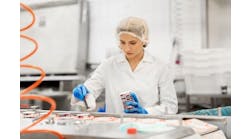“Reduce, reuse, recycle” is the mantra for solid waste. It also applies to wastewater, perhaps with an extra R: recover.
Wastewater conditioning has long been an imperative for many food and beverage processors. Before discharging wastewater to municipal sewers – or, in some cases, directly to waterways – manufacturing plants often find it necessary to reduce its environmental impact with pretreatment. This isn’t just a matter of being a good corporate citizen and neighbor. It’s often required, either as an outright regulation or by surcharges and fines that accrue when wastewater becomes too hard for the municipality to process cost-effectively.
Pretreating wastewater before its release to a city sewer system is often necessary to lower its chemical oxygen demand (COD) and biochemical oxygen demand (BOD), which basically are measures of how fast wastewater will degrade oxygen in fresh water into which it is released. Many municipalities have thresholds for BOD and COD in wastewater discharges; exceeding it triggers fines or surcharges.
Wastewater pretreatment is a significant expense. For a long time, it was seen as more or less of a fixed one – something that had to be done to avoid greater costs down the road. That’s still true, but new technology – or in some cases, established technology that isn’t yet widespread in the industry – is allowing those costs to be cut in two ways: by reducing the space needed for pretreatment and by allowing better recovery of potentially valuable materials.
“Everybody is thinking in terms of how can they use more and waste less,” says consultant Joseph Cotruvo. “Sewage used to be considered something you’ve got to treat and throw away. Well, everybody now understands it’s basically 100% recyclable.”
In and out
Treating wastewater depends on what’s in it and how that can be taken out. Solids and semisolids like fats, oils and greases, collectively known as FOG, can be removed by a number of methods, including filtration, dissolved air flotation (basically, pushing them to the surface of a pond or lagoon with air introduced from below), grease traps and gravity or mechanical separation. Once separated out, these substances become sludge, which can either be landfilled or further treated, depending on the system.
Dissolved pollutants, like sugars, that contribute to BOD loads usually are treated through bioremediation, the use of benign bacteria to break down organic (carbon-based) compounds. Bioremediation is broadly divided into aerobic and anaerobic treatment – that is, with or without air.
Aerobic treatment has been the norm for food and beverage wastewater pretreatment because it’s relatively straightforward and inexpensive in terms of initial cost. Generally speaking, the bacteria in an aerobic system break down organic compounds into carbon dioxide, which dissipates into the atmosphere. Aerobic treatment always requires aeration – the introduction of air into the water body. It also usually requires solids to be separated before treatment.
Anaerobic treatment, as the name implies, has to take place within a tank or other airtight enclosure. This makes it more expensive to build, and usually limits capacity. However, anaerobic systems have an operational advantage, stemming from the fact that they use the sludge—the solids of the wastewater—as their means of bioremediation. The benign bacteria feed off this “activated” sludge as they break down organic compounds.
This saves money two ways. It eats up the sludge, meaning there is less or none to landfill, which saves on trucking and disposal costs. And it generates methane gas as a byproduct, which can be captured and put to work as a heating agent or to power turbines for electricity.
“We figured out how to help food and beverage manufacturers reduce the costs of managing their byproducts,” Fitch says.
Fitch originally wanted to use an existing bioreactor design, but after finding none that fit his needs, he designed his own. It features multiple compartments, the first of which allows solids to settle by gravity. The solids eventually break down into soluble matter, passing to another chamber where they’re converted to biogas (a mixture of methane and carbon dioxide).
Meanwhile, the water remaining gets filtered, usually through ultrafiltration followed by reverse osmosis, to remove dissolved solids like nitrogen, phosphorus, sodium and chloride. (RO, simply put, involves applying pressure to “squeeze” clean water out of wastewater through a membrane. It’s called “reverse” osmosis because that’s the reverse of what would happen with regular osmosis, in which the fresh water would flow into the contaminated water.)
The water that remains is clean enough to be used for clean-in-place and other sanitation. Fitch claims that this source of sanitation water allows one of his clients, a brewery in Kona, Hawaii, to get around limitations on how much municipal water it can use.
“Since they’re recycling their cleaning water, more of the water that they have available from the city can end up in the bottle, instead of going down the drain,” Fitch says. “It increases their brewing capacity by 250%.”
Normally, RO can recover 50-60% of the fresh water available from most batches of wastewater. Desalitech, a wastewater treatment system supplier, says that its “closed-circuit” RO system can recover up to 85% of available water, making the investment worthwhile, says Desalitech account associate Aaron Davis.
Peter Cartwright, a consultant who has worked with wastewater filtration membranes for 45 years, says motivations to recover and reuse water from pretreatment are growing for a simple reason: We’re all running out of the stuff.
“The whole world, and especially the developed world, is starting to look closely at water recovery and reuse,” Cartwright says.
Can you drink it?
In some cases, water recovered from wastewater and treated with RO can be brought up to potable standards. Usually this is too expensive to be practical, since it requires a disinfection step like ultraviolet treatment, and often remineralization and other actions. But Cartwright says it might be worthwhile in some applications.
“If they’re in a water-short area somewhere out West, and they don’t have a lot of potable water, yes, it would be cost-effective,” he says.
PurposeEnergy’s bioreactors, like many others, work on the principle of separating solids by settling them through gravity. That’s what makes them convertible to methane, Fitch says; if they were filtered out first, conversion wouldn’t take place.
However, the downsides to settling solids through gravity are space and time. The pond or tank containing the wastewater has to be big enough to let the solids sink to the bottom. The process can take up to three weeks, which creates its own demand for space, since there has to be enough capacity to store the wastewater during settling.
Recovery of potentially valuable substances, including methane gas and water usable for sanitation, can cut costs of wastewater pretreatment. Photo: Baswood
Filtration, in various forms, is the alternative to settling as a way to separate solids from wastewater. One fast, small-footprint method is with membrane reactor (MBR) technology. MBR involves filtering wastewater with membranes submerged in the bioreactor tank. The tradeoff is that the filters, which contain the microorganisms that break down the wastewater’s pollutants, are liable to clog and must be continually cleaned and changed. But the advantages are that MBR works faster and in less space than systems that use settling, and results in more recoverable water.
“In the past, they haven’t embraced this philosophy of taking this water, treating it at the site and reusing it,” Cartwright says. “Now, there’s all sorts of motivating factors that contribute to this. MBR is probably the most attractive method of recovering water from a typical biotreatment application.”
Veolia combines membrane filtration with methane production in its Memthane system. Memthane is a one-stage anaerobic reactor that separates effluent and biomass by ultrafiltration. The biomass is returned to the reactor and the final effluent is discharged to the sewer system. Memthane is in use in several food and beverage facilities, including the Mars facility in Veghel, Holland, one of the world’s largest chocolate processing plants.
Jolting the microbes
A twist on biological treatment comes from the EcoVolt Reactor from Cambrian Innovation. The EcoVolt combines bacterial digestion with electricity in a proprietary process.
“Some of what is going on in the EcoVolt Reactor is proprietary, but what we can tell you is we use a combination of special bacteria and a series of electrodes to digest the soluble organic matter in a waste stream, generate energy and convert that energy into gaseous methane through a process called electromethanogenesis,” says William Dean, Cambrian’s director of North American sales.
The BioViper system from Baswood uses vertical orientation that combines aerobic and anaerobic treatment in a relatively small footprint.
“One of the most fascinating, yet subtle, qualities of the EcoVolt reactor is the way it uses the electrical current generated in this process to provide a live diagnostic feed that we can use to monitor the health of the system remotely and automate the treatment process,” he adds.
Another alternative method for bioreaction is the BioViper system from Baswood. This uses a unique vertical tank design that allows for a significantly smaller footprint – up to 75% less space than a traditional bioremediation system would need to handle the same load, says Baswood CEO Dan Simon.
The Baswood system combines aerobic and anaerobic treatment within one system, feeding wastewater sequentially though a series of reactors. As the wastewater passes through each reactor, it is exposed to distinct treatment zones, first aerobic, then anaerobic, that allow the technology to maximize sequential biological treatment, resulting in accelerated BOD digestion.
The choice between aerobic treatment, anaerobic treatment or both is a fundamental one for any operation embarking on wastewater pretreatment. Evoqua Water Technologies provides both, and helping customers choose is one of its most important services, says Barry Reicker, vertical market manager for food.
“Sometimes the best option is both,” Reicker says. “The biggest determining factors are wastewater BOD/COD, TSS [total suspended solids], FOG and nutrient concentration and daily organic load. High strength wastewaters tend to have better paybacks available for anaerobic because the cost of treating them aerobically or paying the surcharge is so high.”
Industrial wastewater pretreatment is expensive but often necessary to avoid even higher expense. Improved technology can help not only to decrease that expense, but to make the wastewater’s long-term impact on the environment more benign.


